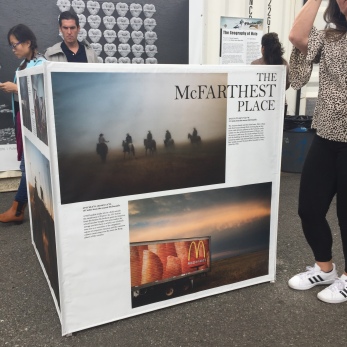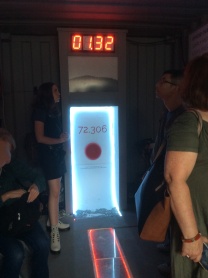Photoville specializes in throwing light where there is darkness. These five examples are beacons of creative curiosity paired with intelligent investigation. While diverse in subject matter, each exhibit shares a common intent – to reveal truth and clarify its relationship to power.
The San Francisco-based non-profit, Catchlight, works to amplify visual story-telling to drive positive social change. Their exhibitions honored three inaugural Catchlight Fellows. Sarah Blesener in New Americanism highlights the intersection of youth, religion, nationalism and military-style training. In Out of Bounds Brian L. Frank gives an intimate portrayal of targeted policing and criminalization of youth in marginalized communities. Tomas Van Houtryve looks at the weaponization of photography through the use of drones and other technology in Blue Sky Days. Each artist documents current U.S. activities which ask viewers to consider the complexity and validity of our national narrative. (This exhibition printed and sponsored in part by Digital Silver Imaging.)

The McFarthest Place is an EmergiCube based on the inspired idea of photographer Mark Kauzlarich, namely; how far away could one live from a McDonald’s restaurant? He discovers it to be a county in South Dakota and documents the social, economic and political landscape of this slice of rural Western life. EmergiCubes, scattered throughout Photoville, feature emerging photographers culled from the New York Times Portfolio Review. Co-Founders and Editors of the Lens Blog, James Estrin and David Gonzales, select participants and co-curate these exhibitions. Read about each of these talented artists here.
The Photo Agency VII is a powerhouse of international photographers known for their global social documentary coverage. Seven women photographers, photojournalists and filmmakers from this collective are featured in Her Take:(Re) Thinking Masculinity. Expanding on a conversation begun at their last annual meeting this exhibition provides a format to move forward an inclusive dialogue on gender, power and representation. Anush Babajanyan, Jessica Dimmock, Linda Bourname Engelberth, Ilvy Njiokiktjien, Nichole Sobecki, Maggie Steber and Sara Terry each reflect a unique and nuanced perspective to (re)consider.

Luceo is a creative visual agency which builds transmedia platforms to inform public perception and move us towards a positive future. This year their exhibit sought to humanize drug use, to shift our public policy focus from a criminal lens to a public health one, and to decrease the stigma associated with injection drug use. Stemming from their collaboration with the Colorado-based, Harm Reduction Action Center, Luceo created the immersive experience, 72,306. It actualized in concrete forms the reality of our current overdose epidemic. A bell was sounded every seven minutes and 41 seconds (how often a death via overdose occurs) and a metal ball was released down a chute to add to last year’s total of 72,306 overdoses. Simultaneously, a wall of portraits simulating the individual drug users went from a black and white image to a red one. Visitors could not escape being emotionally moved by the reenactment of the facts.
Amsterdam-based photographer Léon Hendrickx explores drag queens’ identity beyond exhibitionism in Kings and Queens. The subject, as collaborator, staged the location, wardrobe and pose of these compilation portraits featuring themselves in and out of drag. Hendrickx’ exploration looks at identity, love, and gender. He unearthed more questions than answers within the entity he coined sexual transcendence. The exhibition was supported by the Consulate General of the Netherlands in New York. A book of the work is expected to be released in October 2020 and is available for pre-order here.
This post re-published with the permission of J. Sybylla Smith. Sybylla is available for consultation, teaching, curating and lectures @Â https://jsybyllasmith.wordpress.com.















